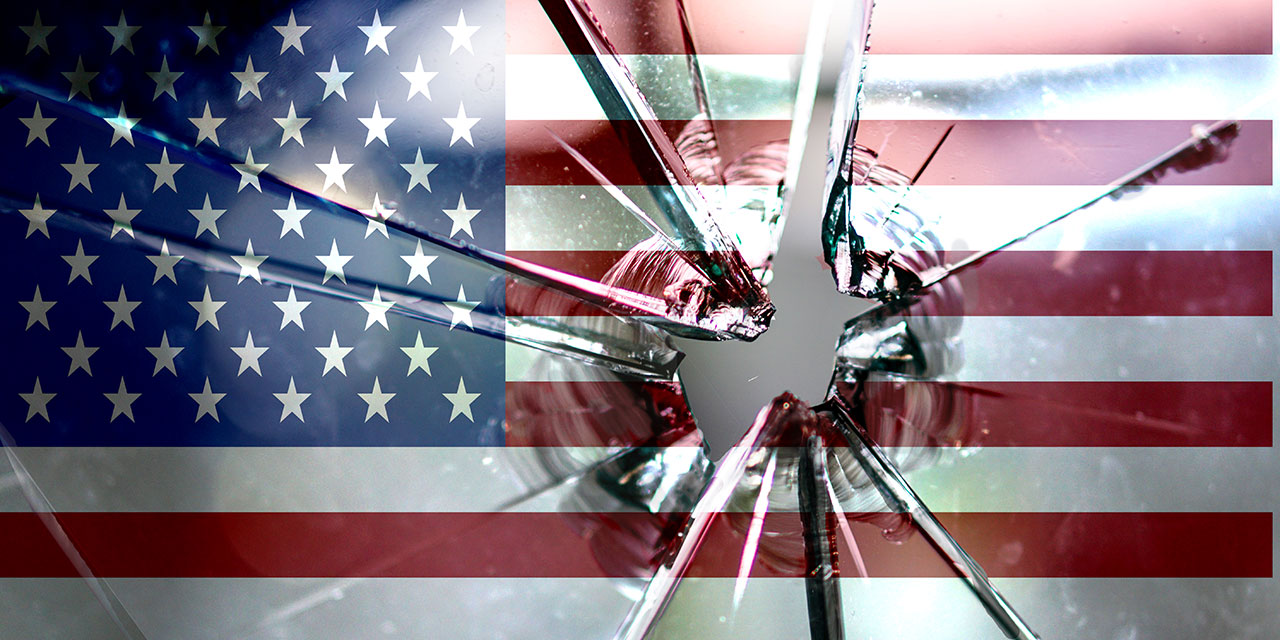Who Really Started Culture War in America?

Over the past few years, Western elites have attempted to present the culture war as the work of right-wing agitators. Establishment politicians, pundits and academics claim that it’s the socially conservative who are fuelling today’s cultural conflicts for their own political gain. As one New York Times columnist argued, the likes of Donald Trump have been attacking trans ideology or critical race theory in order to scare and mobilise their voters.
Richard Slotkin’s critically acclaimed A Great Disorder: National Myth and the Battle for America aims to go beyond this simplistic view. He tries to provide historical context and an explanation for the culture war that is now raging in the US. To this end, he attempts to root today’s cultural conflicts in competing national myths, each presenting a ‘different understanding of who counts as American, a different reading of American history and a different vision of what our future ought to be’.
These myths include the myth of the frontier (or the myth of the American West) and two myths around the Civil War – namely, that of emancipation and that of the ‘lost cause’. Of these myths, Slotkin objects most to the lost cause myth. This, he argues, presents the Confederacy’s role as a noble but vain attempt to maintain a virtuous way of life rather than an effort to preserve the institution of slavery. To these myths, Slotkin adds the myth of the ‘good war’ and the myth of ‘the movement’, a reference to the civil-rights activism of the mid-20th century. The aim is to show how these different national stories continue to provide the resources on which political actors today still draw.
There’s no doubting the ambition of A Great Disorder. But like most liberal-ish American academics writing about the culture war, Slotkin shares the elite view that these conflicts are ultimately the invention of right-wing conservative activists. In effect, A Great Disorder absolves leftists and ‘progressives’ of any responsibility for the cultural battles being fought in our midst.
The tale Slotkin tells is a familiar one. According to this liberal-elite narrative, today’s culture war began with conservative Pat Buchanan’s primetime address at the 1992 Republican National Convention. This is when Buchanan announced to the nation that ‘there is a religious war going on in this country. It is a cultural war, as critical to the kind of nation we shall be as the Cold War itself, for this war is for the soul of America.’
Slotkin argues that ‘culture-war conservatism’ was effectively launched at the 1992 Republican National Convention. He writes that it was rooted in ‘the combination of populist reaction against economic strains of the globalised economy and the anxieties of conservative white Christians at their loss of cultural authority and political power’.
In Slotkin’s telling, the supposedly irrational and anxious populist moment of the early 1990s is the precursor to Donald Trump and his Make America Great Again (MAGA) brand of Republicanism. It is the moment ‘conservative white Christians’, angry at their loss of power, start to wage a war for ‘America’s soul’. This tendentious story is underpinned by the familiar contention that Trump’s MAGA movement is the heir to America’s dark legacy of white racism

Slotkin does provide an interesting analysis of America’s national myths. But the ultimate aim of it all is to use this version of America’s past to delegitimise support for Trump. In A Great Disorder, all roads, from the myth of the frontier to that of the lost cause, lead to the supposed evil of Trumpism. Along the way, we are reminded, as we so often are in these accounts, that the Buchanan-era conservatism that begat MAGA leads not only towards populism but fascism, too. This willingness on the part of academics to portray Trump’s Republican Party as fascistic crosses the line separating scholarship from propaganda. It is an inverted form of Whig history, with the old liberal faith in steady progress replaced by a conviction that we’re heading towards social and political catastrophe.
This is a profoundly misleading but widespread interpretation. Blaming conservatives for the culture war – for starting and waging it – is to misunderstand the culture war fundamentally. The conservative right’s involvement is far better understood as a backlash against long-standing attacks on America’s traditions, values and history. It is the response, not the cause.
Yet too many liberal commentators and academics see the conservative backlash against the attacks on the taken-for-granted dimensions of American culture as if it was itself the spark for the culture wars. Take the New York Times’ 1619 Project, launched in 2019. This overtly ‘progressive’ project claimed that 1619 when 20 Africans arrived in the English colonies, not 1776, marked the beginning of America – it’s ‘true founding’. According to the New York Times, the US was forged to preserve slavery, not for the freedom and equality promised by the Declaration of Independence. America is,, therefore,, a racist nation by design and thus illegitimate, according to the 1619 Project.
This is a clear attempt to rewrite and politicise American history. However, for the likes of Slotkin, it was the conservative reaction against the 1619 Project’s attack on America’s founding myth that constituted an act of culture war. As Slotkin puts it, Trump ‘made the [1619 Project’s] interpretation of American history – which is to say the meaning of our national myth – the explicit focus of the ideological conflict’.
Yet the 1619 Project was itself explicitly ideological. It was designed to contaminate the traditions and history that underpin the American way of life. Indeed, one of the primary authors of the 1619 Project, Nikole Hannah-Jones, was clear about the project’s aims. She wanted to use the past to undermine the moral authority of the present-day US. She responded to critics who claimed that she had distorted history by stating: ‘I’ve always said that the 1619 Project is not a history. It is a work of journalism that explicitly seeks to challenge the national narrative and, therefore, the national memory.’
Hannah-Jones clearly saw the 1619 Project as a political challenge to America’s national history. Yet, from the perspective of today’s liberal elites, it is only ever social conservatives politicising history and culture. This selective interpretation of the culture war is writ large in A Great Disorder – particularly in the section, ‘Framing a Culture War Ideology, 1994-2000’. Having argued that Buchanan had launched ‘culture-war conservatism’ in 1992, Slotkin then claims that Newt Gingrich’s ‘Contract with America’ document, published ahead of the 1994 Midterms, represented the first attempt ‘to weaponise Pat Buchanan’s culture-war rhetoric in a political contest’. In particular, he claims that one of the key elements of Gingrich’s ‘Contract with America’, which helped Republicans regain the House, was its characterisation of Democrats as ‘liberals’ and its attempt to culturally ‘other’ them as alien enemies of normal Americans. Like so many liberals and ‘progressives’, Slotkin appears to be utterly oblivious to his own side’s ‘othering’ of conservatives by conjuring them up as fascists and racists.
Furthermore, to situate the origins of the culture war in the early 1990s is misleading. It overlooks that this conflict had raged for decades before Buchanan’s speech. Its origins can be traced back to the late 1950s and 1960s American counterculture movement. This revolt may have attacked the legitimacy of political institutions, but they could weather the challenge. Matters were very different in the cultural sphere, which is where this revolt struck deepest. As the Italian author, Umberto Eco, once remarked: ‘even though all visible traces of 1968 are gone, it profoundly changed the way all of us… behave and relate to one another. He added that ‘relations between bosses and workers, students and teachers, even children and parents, have opened up’ and therefore ‘they’ll never be the same again’.
One reason why it is difficult to capture the dynamic of the culture war that began in the 1960s is that it rarely assumed an explicit and systematic character. That is why so many commentators and academics were able to insist that right-wingers exaggerated claims of a culture war. Some even denied the existence of the phenomenon of political correctness during the 1980s and 1990s.
Slotkin himself shares the view that PC was a conservative invention. He writes that right-wingers lumped together ‘movements against racist speech on college campuses and denounced them as an emerging ideology of “political correctness”’. Indeed, criticism of political correctness has been continually met with angry denials of its existence and the counter-assertion that it is a desperate attempt by reactionaries to justify their prejudices and bigotry. The fact that PC undermines free speech – one of America’s core, foundational values – is actually seen as a positive among self-styled progressives.
The reluctance in recent decades to openly discuss these conflicts over culture is perhaps understandable from one perspective. Officials and policymakers fear the divisive and explosive consequences of any open contestation of cultural values. Social commentator Daniel Bell was convinced that divisive cultural, moral questions had to be depoliticised because they are, ‘by their nature, non-negotiable and can only invite public conflict’.
Buchanan’s speech was noteworthy not for starting the culture war, but for drawing attention to its existence – and for doing so at a national political convention in front of the world’s television cameras. Unlike military or ideological battles, the culture war to which Buchanan drew attention had essentially been a silent one up to that point. After his speech there was a greater willingness to acknowledge the fact that party-political conflict, particularly in the US, needs to focus on values rather than solely on economic issues. Moreover, it is now widely recognised that conflicts over cultural values are far more corrosive than disputes over other political or economic matters. That is also why in Western societies there is often a reluctance among our elites to openly engage with cultural insecurities over multiculturalism, immigration and national identity.
Ironically, those trying to cast conservatives as socially divisive instigators of the culture war are often the most socially divisive of all. Slotkin captures this phenomenon well. A Great Disorder wants to connect slavery, racism and the Confederacy to what he considers to be their present incarnation in Trump and the MAGA movement. Adherents are cast as neo-fascists, the 21st-century equivalent of the Brown Shirts. According to Slotkin:
‘The MAGA movement has thus become the vehicle for the development of an authentically American fascism: more neo-Confederate than neo-Nazi, an amalgam of American exceptionalism and Christian nationalism. Its self-concept and belief system are historically rooted in traditional forms of American national mythology… It roots its world concept in the myths of the frontier and the Lost Cause and therefore sees itself fighting a Last Stand to save America from “replacement”.’
ALSO READ: Nigeria’s Nathaniel Bassey to Minister at Trump’s Inaugural Prayer Breakfast
Like so many others, Slotkin gets seriously carried away with the Nazi analogies. For him the violent riot in Washington, DC on 6 January 2021 is akin to the Beer Hall Putsch, Adolf Hitler’s failed coup d’état in 1923. Trump is basically another Hitler, is the message.
A Great Disorder ends with a warning about the global ascendancy of populism. This is a typical refrain among our cultural elites at the moment. They regard the populist reaction to their own attack on Western nations’ traditions and ways of life as the real source of cultural conflict. And they then dress up the populist pushback as the second coming of fascism.
Written before Trump’s election victory in November, A Great Disorder expresses considerable anxiety about the possible return of The Donald to the White House. Expecting what he sees as the worst, Slotkin concludes by calling for the building of a coalition to resist the result of a democratic election.
This is the view from on high. It is the view of those who have little understanding of the motives of the millions of Americans – white, black, Hispanic – willing to give their vote to Trump. The view of those who lack any empathy for the predicament that confronts these citizens. And this is why they are incapable of taking the voices of all sides of the culture war seriously.






